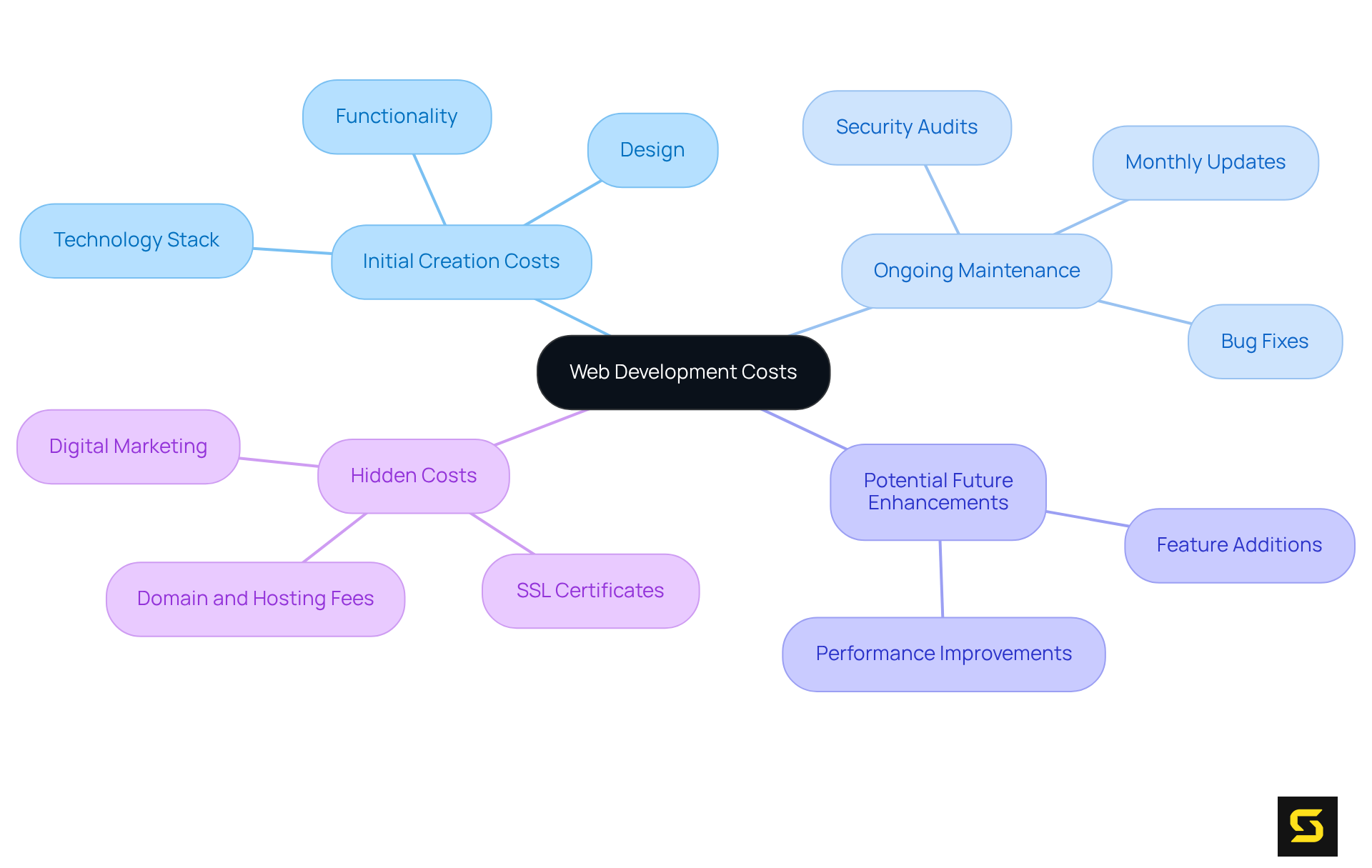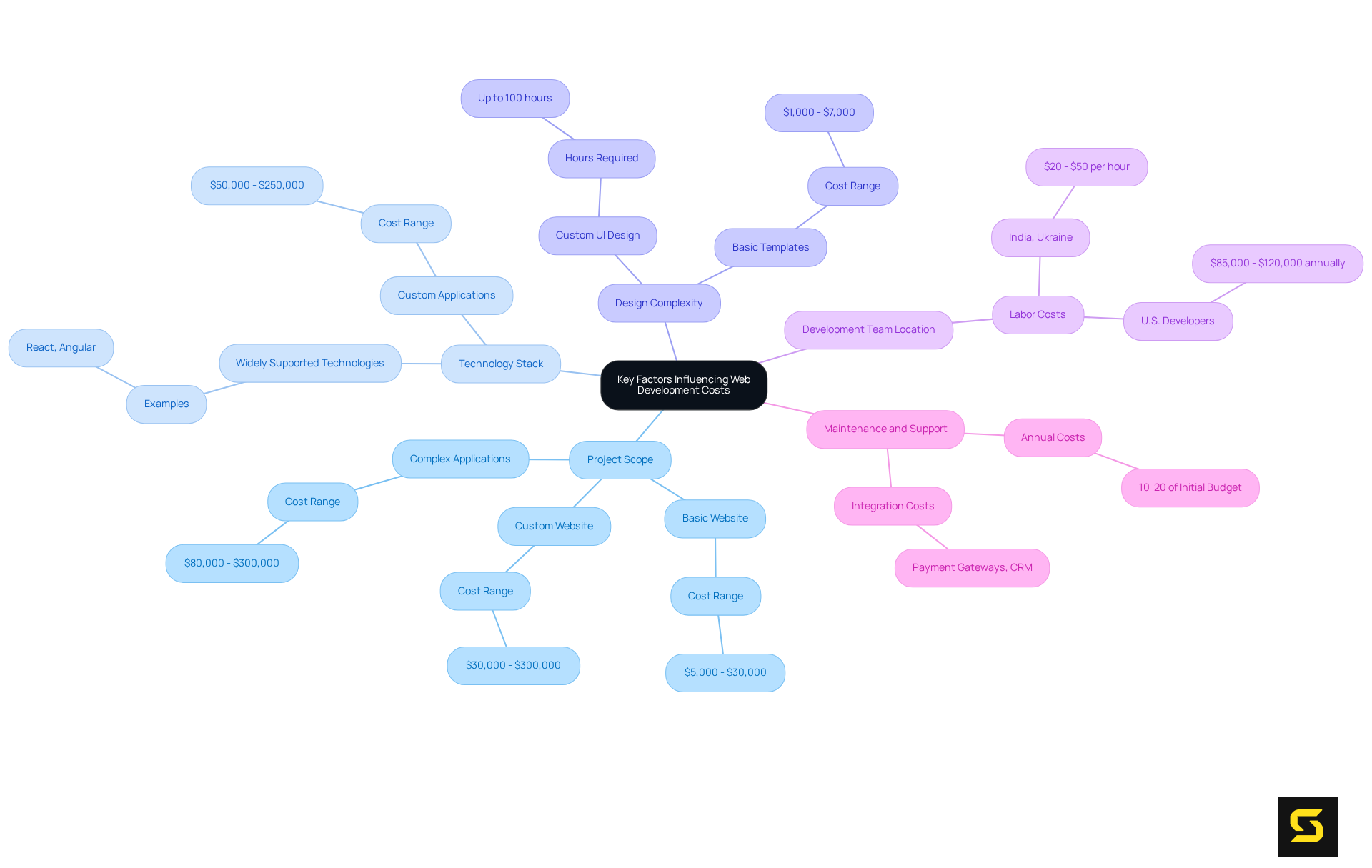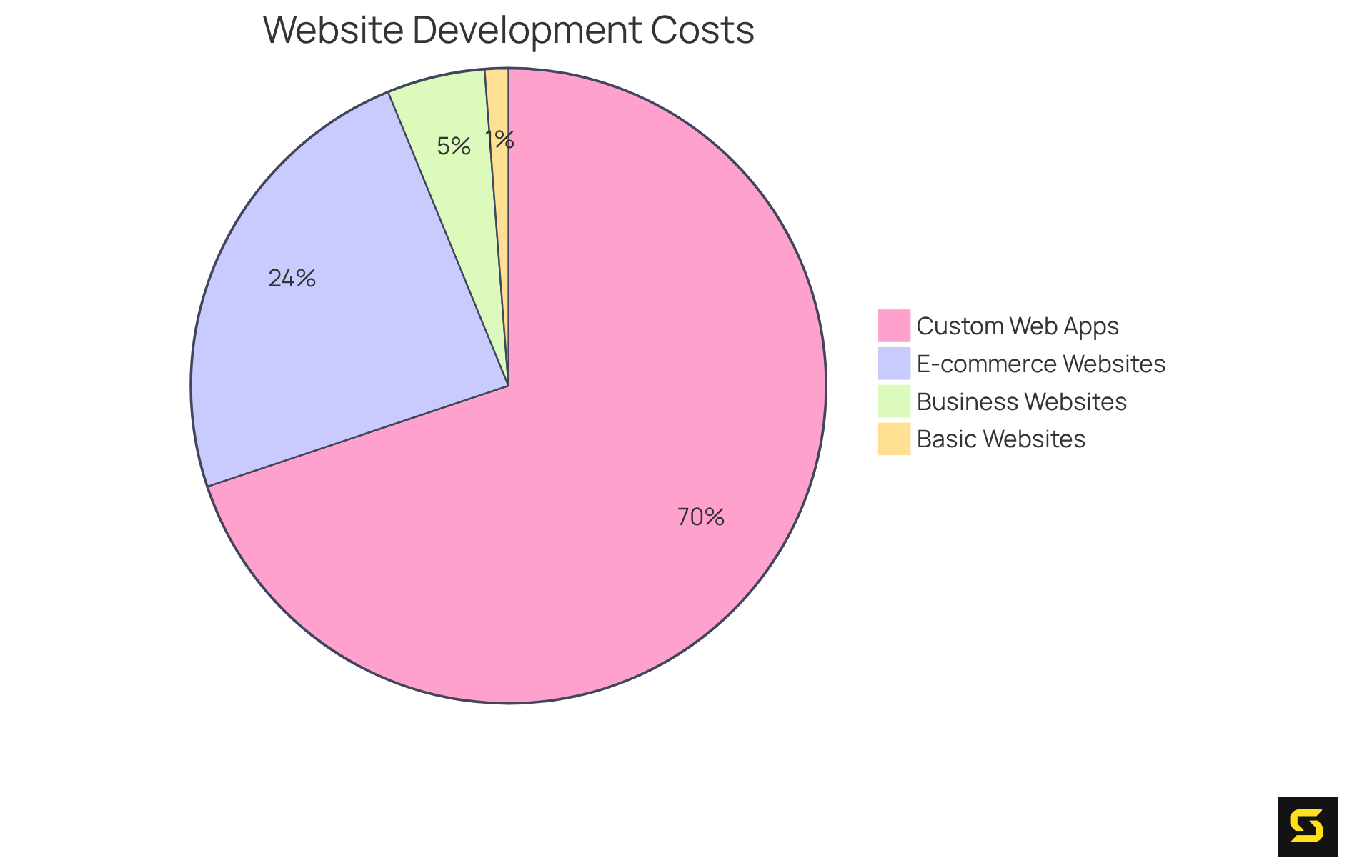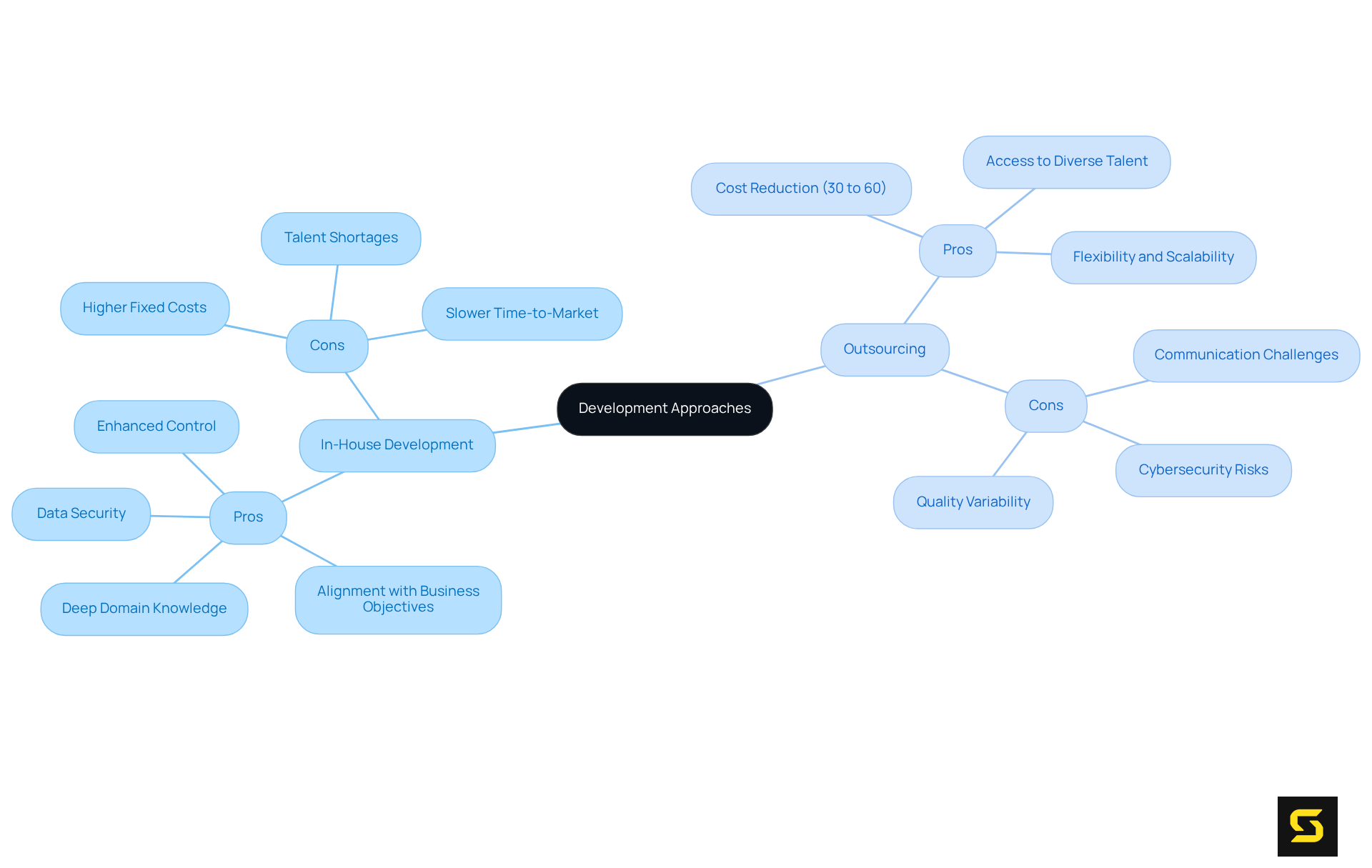Overview
This article delves into the various costs associated with web development for SaaS owners, highlighting the critical aspects of initial creation costs, ongoing maintenance, and potential future enhancements.
Understanding these costs—ranging from $10,000 to over $300,000 depending on complexity and features—is essential for effective budgeting and planning in SaaS development.
By grasping the financial implications, SaaS owners can strategically allocate resources and make informed decisions that drive success.
Introduction
Understanding the financial landscape of web development is essential for SaaS owners as they navigate the complexities of launching and maintaining their applications. With costs ranging from a modest $1,000 for basic websites to over $300,000 for sophisticated custom applications, the stakes are undeniably high. This article explores the multifaceted nature of web development expenses, examining key factors that influence pricing—from project scope and technology stack to ongoing maintenance and hidden costs.
How can SaaS proprietors effectively budget for these expenses while ensuring their applications remain competitive and compliant in an ever-evolving digital landscape?
Fundamentals of Web Development Costs
The cost for web development includes a variety of elements, such as design, functionality, and technology stack. These expenses can be categorized into:
- Initial creation costs
- Ongoing maintenance
- Potential future enhancements
All of these contribute to the overall cost for web development. By understanding these categories, SaaS owners can effectively anticipate expenses and allocate their budgets. The cost for web development typically ranges from $10,000 to $300,000, influenced by the and functionalities. Additionally, the cost for web development may increase by an extra 15-20% of the initial development expenditure each year due to continuous maintenance, which is crucial for keeping the software current and secure.
SaaS proprietors must also consider potential hidden costs for web development, including:
- Digital marketing
- Domain and hosting fees
- SSL certificates
when planning their budgets. Starting with a Minimum Viable Product (MVP) can significantly reduce initial expenses and facilitate quicker feedback. Furthermore, grasping various pricing models for SaaS development, such as Fixed-Price Contracts or Time-and-Materials, provides valuable insights into the cost for web development and budgeting strategies. It is essential to prepare for scalability from the outset, as this decision will influence the cost for web development and long-term budgeting. Lastly, compliance obligations, such as HIPAA and GDPR, can considerably affect costs, especially for applications that handle sensitive information.

Key Factors Influencing Web Development Costs
Several factors significantly influence the cost for web development, and understanding these elements is crucial for effective budgeting.
Project Scope: The size and complexity of a project directly affect costs. Larger projects with numerous functionalities demand additional resources and time, leading to increased expenses. For instance, custom website creation can range from $30,000 to $300,000, depending on the features and team involved. Conversely, a basic website may range from $5,000 to $30,000. More complex applications can cost between $80,000 and $300,000, influenced by the number of functionalities and integrations required.
Technology Stack: The choice of programming languages and frameworks plays a pivotal role in determining both development speed and costs. Utilizing widely supported technologies such as React or Angular can help reduce expenses due to the availability of skilled developers. As of 2025, the typical cost for web development of a custom application starts at $50,000 and can exceed $250,000, largely influenced by the selected technology stack.
Design Complexity: Custom designs and user interfaces can significantly elevate expenses. Bespoke UI design may require up to 100 hours of specialized work, generally increasing costs due to the need for expert input. While enhance user experience, they demand more development time and expertise. In contrast, simple templates are more cost-effective, with basic brochure websites typically costing between $1,000 and $7,000.
Development Team Location: Engaging developers from regions with lower labor costs can lead to substantial savings. For example, labor rates in countries like India and Ukraine range from $20 to $50 per hour, compared to $85,000 to $120,000 annually for mid-level developers in the U.S.
Maintenance and Support: Ongoing costs for updates, bug fixes, and customer support should also be factored into the budget. Typically, the cost for web development includes maintenance expenses that represent 10-20% of the initial development budget each year, underscoring the importance of planning for long-term financial commitments. Furthermore, integrating external systems such as payment gateways or CRM systems can significantly increase expenses, particularly for complex projects. Utilizing cloud services can also lower costs for web app projects compared to investing in on-premise hardware.

Cost Breakdown by Website Type and Complexity
The cost for web development varies significantly based on the type and complexity of the website. Understanding the is crucial for SaaS product owners as they effectively plan their budgets and scope of work. Here’s a comprehensive breakdown:
- Basic Websites: Typically ranging from $1,000 to $5,000, these sites encompass simple landing pages or portfolios with minimal functionality. For example, a basic blog might cost between $50 and $100 annually, while a local bakery's website using platforms like Squarespace could be approximately $236 per year.
- Business Websites: Priced between $5,000 and $20,000, these websites often feature more complex functionalities such as contact forms, blogs, and basic e-commerce capabilities. Mid-sized companies generally allocate between $15,000 and $50,000 for websites with sophisticated functionalities, reflecting the demand for enhanced features.
- E-commerce Websites: The costs for these sites can span from $20,000 to $100,000, influenced by factors such as the number of products, payment gateways, and custom features required. For instance, a boutique clothing website may necessitate an investment of around $6,000, whereas a comprehensive direct-to-consumer shop with extensive product offerings could easily exceed $25,000.
- [Custom Web Applications](https://sda.company): For SaaS products or complex applications, expenses can range from $50,000 to over $300,000. This pricing is determined by the required features, integrations, and user experience design. For example, developing a platform similar to Airbnb may involve an expenditure between $100,000 and $150,000, underscoring the significant investment needed for advanced applications.
Grasping these pricing frameworks is essential for SaaS product owners to efficiently organize their budgets, including the cost for web development and the scope of work.

Evaluating Development Approaches: In-House vs. Outsourcing
When evaluating development approaches, it is essential to weigh the pros and cons of in-house development against outsourcing.
In-House Development: This method offers enhanced control and alignment with business objectives, making it particularly suitable for companies with ongoing development needs and a focus on long-term projects. However, it incurs greater fixed expenses, including salaries, benefits, infrastructure, and the cost for web development. Organizations may find in-house teams advantageous for initiatives requiring deep domain knowledge and strict data security. Yet, they must also confront challenges such as and slower time-to-market.
Outsourcing: This strategy frequently leads to substantial cost reductions, often ranging from 30% to 60%, while granting access to a diverse talent pool. Outsourcing proves especially beneficial for startups or initiatives with a defined scope and timeline, as it enables greater flexibility and scalability, which can help manage the cost for web development. Additionally, the trend toward nearshoring is gaining popularity to mitigate time zone challenges. However, outsourcing may introduce challenges in communication and project management, particularly when collaborating across different time zones and cultures. Companies can mitigate these risks by selecting experienced vendors and establishing clear communication protocols. It is also crucial to consider the potential cybersecurity and compliance risks associated with sharing sensitive information during outsourcing, especially in regulated industries.
In 2025, the trend toward outsourcing continues to grow, particularly for startups seeking to launch quickly and efficiently. By leveraging external expertise, businesses can concentrate on their core strengths while ensuring high-quality development outcomes. Furthermore, many organizations are adopting a hybrid model that combines in-house and outsourced resources, effectively balancing control with flexibility.

Conclusion
Understanding the costs associated with web development is crucial for SaaS owners who aspire to manage their budgets effectively. Web development expenses can be categorized into:
- Initial creation costs
- Ongoing maintenance
- Future enhancements
All of these are pivotal in the overall financial planning of a project. By comprehending these categories, SaaS proprietors can better anticipate their expenses and make informed decisions that align with their business objectives.
Key insights reveal the significant impact of:
- Project scope
- Technology stack
- Design complexity
on development costs. Moreover, it is essential to consider hidden costs, such as digital marketing and compliance obligations, which can greatly influence the total budget. The choice between in-house development and outsourcing presents distinct advantages and challenges; outsourcing often provides cost savings and access to a broader talent pool.
Ultimately, a comprehensive understanding of web development costs empowers SaaS owners to navigate the complexities of budgeting and project management. By leveraging this knowledge, businesses can optimize their strategies for development, ensuring they remain competitive in an ever-evolving digital landscape. Taking proactive steps in planning and evaluating options will not only enhance financial efficiency but also contribute to the long-term success of their web applications.
Frequently Asked Questions
What are the main categories of web development costs?
The main categories of web development costs include initial creation costs, ongoing maintenance, and potential future enhancements.
What is the typical cost range for web development?
The cost for web development typically ranges from $10,000 to $300,000, depending on the application's complexity and functionalities.
How much can ongoing maintenance add to the initial development costs each year?
Ongoing maintenance can increase costs by an additional 15-20% of the initial development expenditure each year.
What are some potential hidden costs associated with web development?
Potential hidden costs include digital marketing, domain and hosting fees, and SSL certificates.
How can starting with a Minimum Viable Product (MVP) help with web development costs?
Starting with a Minimum Viable Product (MVP) can significantly reduce initial expenses and facilitate quicker feedback.
What pricing models are available for SaaS development?
Common pricing models for SaaS development include Fixed-Price Contracts and Time-and-Materials.
Why is it important to prepare for scalability in web development?
Preparing for scalability from the outset is essential as it influences the cost for web development and long-term budgeting.
How do compliance obligations affect web development costs?
Compliance obligations, such as HIPAA and GDPR, can considerably affect costs, especially for applications that handle sensitive information.





